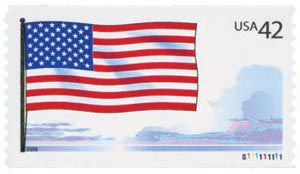
# 4283-92 - 2008 42c Flags of Our Nation: 2nd Edition
The state and territory flags of the U.S. offer a unique glimpse into the history of each place. Every flag features important people, dates, places, or events that are significant to each state or territory. In many cases, the choice of color is a deliberate reference to something in the state's background. Many of the current U.S. state flags date back to the 1890s. At that time, states wanted to have unique symbols of representation for display at the 1893 World's Columbian Exposition.
In 1938, a design created by graphic designer Charles A.R. Dunn was officially adopted as the flag of the District of Columbia. Inspired by George Washington's family coat of arms, the flag design consisted of three red stars (known as mullets) and two red bars.
The first state flag of Florida was created in 1868. It consisted of the State Seal of Florida on a white field. In 1985, realizing the inaccuracies of the state seal, the Florida government changed its design. It now has a Seminole Indian woman, a sabal palm tree (the official Florida state tree), and a more appropriate boat than the previous seal.
In 2003, after countless flags and years of discussion, newly elected Georgia Governor Sonny Perdue resolved to put an end to this dispute. The new flag consisted of the "stars and bars" from the first flag of the Confederate States of America, with the Georgia State Seal in the blue canton.
The flag of Guam consists of a red border, representing the blood shed by the people of Guam while under Spanish rule and during World War II. Within the border is a blue field, symbolic of the Pacific Ocean which surrounds the island. The central focus of the flag is the Great Seal of Guam. The seal is designed in the shape of a sling stone, which was used by the native Chamorro people to hunt and fight, symbolizing survival. Inside the sling stone is a coconut palm, symbolizing perseverance and sustenance. There is a canoe, known as a flying proa, which represents courage and freedom. The seal also shows a river leading to the sea, showing Guam's readiness to share its resources. In the background is Two Lovers' Point, representing Guam's faithfulness and commitment to its future people.
Hawaii's state flag has remained virtually unchanged since its creation in 1816. The flag consisted of eight red, white, and blue stripes with the flag of Great Britain in the upper-left corner. The eight stripes represent the eight main islands of Hawaii, while the Union Jack (another name for the flag of Great Britain) symbolizes the friendship between Hawaii and Great Britain.
The Idaho state flag was first flown in 1898 during the Spanish-American War as the banner of the First Idaho Volunteer Infantry. At the center of a blue field is the Great Seal of the State of Idaho. Within the seal are a woman (representing liberty), a miner, and other symbols honoring the state's rich history in forestry, farming, mining, and wildlife.
Illinois' state flag was officially adopted on July 16, 1915. In 1970, the flag was redesigned to include the state name. The flag features a bald eagle, representative of the United States, carrying a shield with 13 bars and stars to symbolize the 13 original colonies.
On a blue field, the Indiana state flag pictures a flaming torch, symbolizing liberty and enlightenment, and six rays, representing the expansive nature of these ideas. A circle of 13 stars represents the 13 original colonies, while a smaller circle of five stars represents the five states admitted after the formation of the United States. Directly above the torch is a larger star, signifying Indiana as the 19th state.
Iowa's state flag features an eagle on a white stripe between a red stripe (for courage) and a blue stripe (for loyalty, justice, and truth). The state name is written below the eagle in red, to symbolize the sacrifices of the men who went to war.
At the center of the Kansas state flag is the Great Seal of the State of Kansas, which pictures a landscape before the rising sun, a river and steamboat (signifying commerce), a cabin with a man plowing a field (representing agriculture), and a wagon train heading west (depicting American expansion). Also pictured is a group of Indians hunting buffalo. The cluster of 34 stars symbolizes Kansas' role as the 34th state of the American Union.
The Flags Of Our Nation Series
The state flags had been honored on US stamps once before, in 1976 as part of the Bicentennial Series (US #1633-82). Those stamps marked an important first – they were America’s first 50-stamp se-tenant. The sheet featured all of the state flags in the order the states were admitted to the Union.
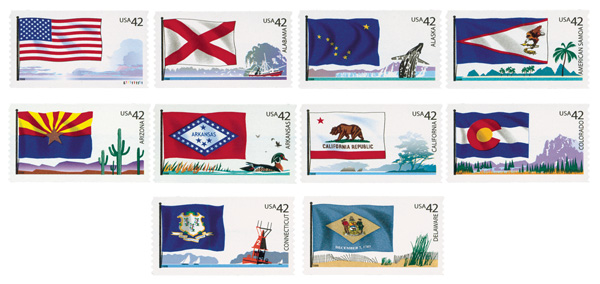
In 2008, the USPS again decided to honor the state flags but in a different format. These stamps represented a US postal first. They have the beauty and historic significance of commemorative stamps, but were issued as se-tenant (face-different attached) definitive coil stamps.
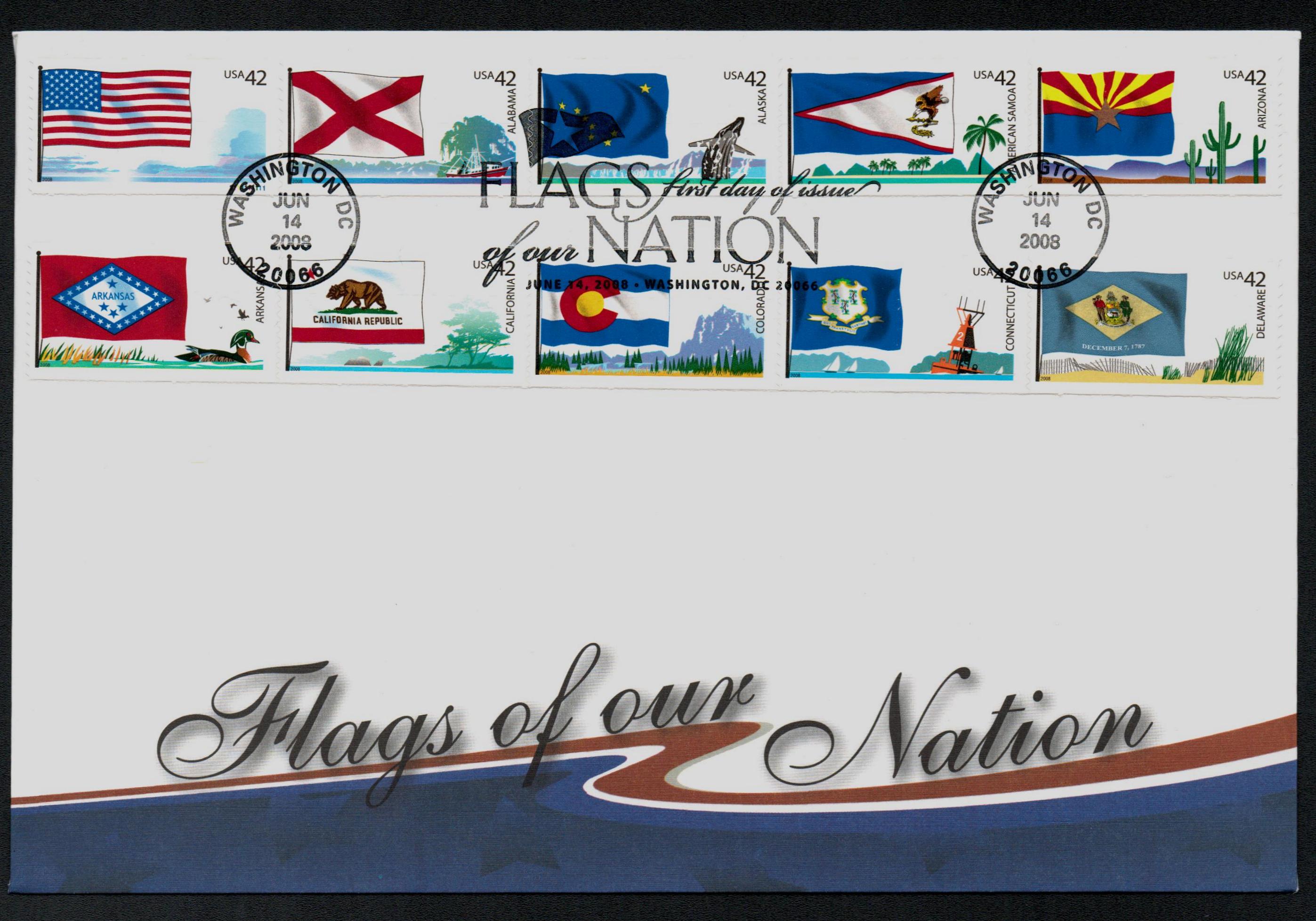
The new series was called “Flags of Our Nation” and would consist of 60 stamps total – 50 featuring state flags, five territorial flags, the District of Columbia flag, and four US flags flying over American landscapes described in “America the Beautiful.” The stamps in the new set would be issued in alphabetical order by state or territory. Each stamp would feature a flag and a “snapshot” from the state or territory. These snapshots would include scenic areas, plants, animals, and more.
The first set of stamps was issued on Flag Day, June 14, 2008 at the National Postal Museum in Washington, DC. It featured the flags of Alabama through Delaware, American Samoa, and the American flag with “spacious skies.”
In speaking about the stamps, a USPS representative said, “Flags are our nation’s greatest symbols for unity and pride and the values we hold dear. The Postal Service is proud to present this tribute as we honor our nation’s flags.” That same day, special events were held in the nine state capitals whose flags were featured in that first set of stamps.
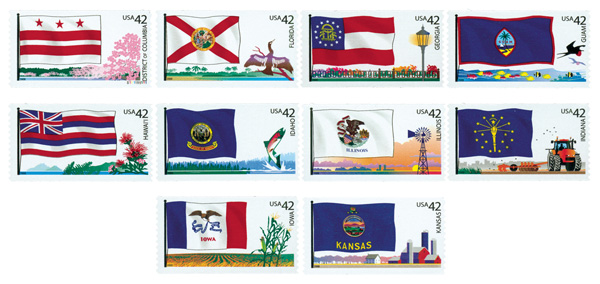
The second set in the series was issued later in 2008, on September 2. As with the first set, there were special ceremonies in the state capitols of those states featured on this set of stamps. The stamps in this set featured the flags of Florida through Kansas, the District of Columbia and Guam.
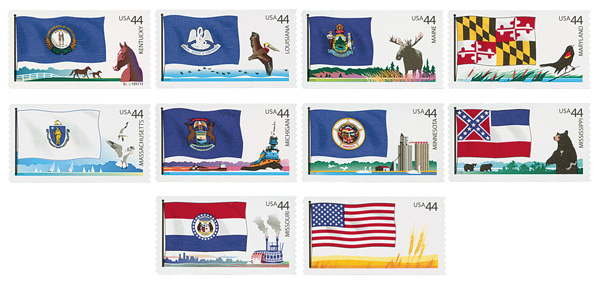
Initially, two sets of 10 stamps were supposed to be issued each year for three years. However, in 2009 it was decided that each year would only include the issue of one set of 10 stamps. The third set was issued on August 6, 2009 at the American Philatelic Society Stamp Show in Pittsburgh, Pennsylvania. These stamps featured the flags of Kentucky through Missouri as well as the US flag with “amber waves of grain.”
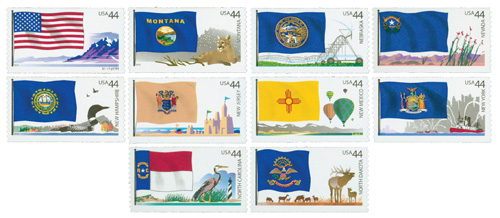
The fourth issue in the series was released on April 16, 2010 at the Mega Stamp Show in New York City. These stamps featured the flags of Montana through North Dakota with the US flag above “purple mountain majesties.”
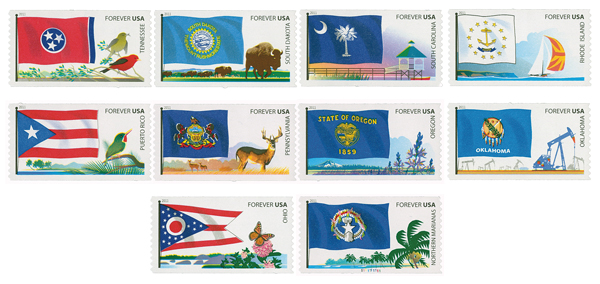
The fifth set was issued on August 11, 2011, at the American Philatelic Society Stamp Show, in Columbus Ohio. These were the first in the series to be issued as Forever stamps. Featured on these stamps were the flags of Ohio through Tennessee, Puerto Rico, and the Northern Mariana Islands.
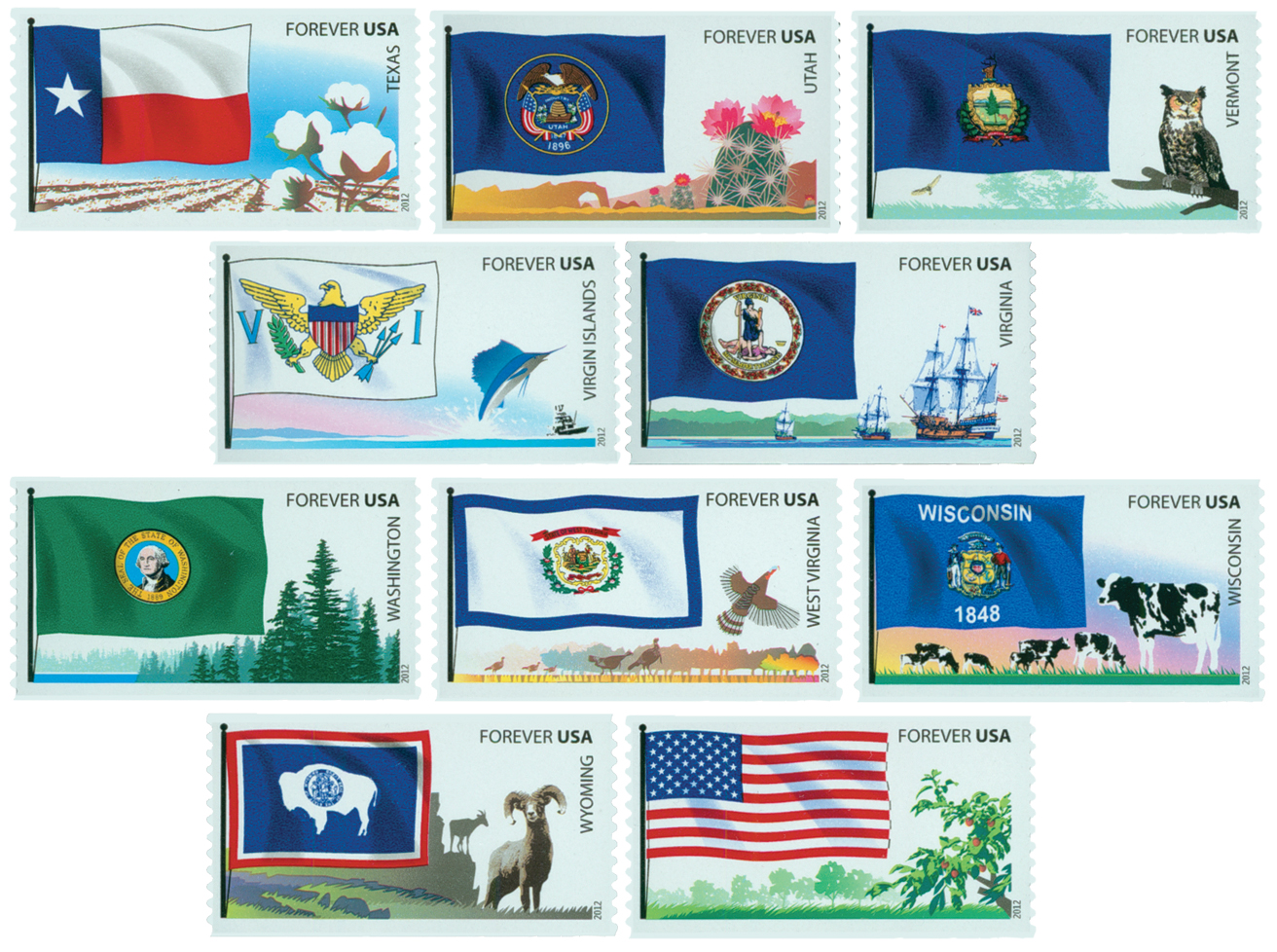
The series came to a close on August 16, 2012, with the sixth and final set. These stamps were issued at the American Philatelic Society Stamp Show in Sacramento, California. Featured on these stamps were the flags of Texas through Wyoming, the Virgin Islands, and the US flag with “the fruited plain.”
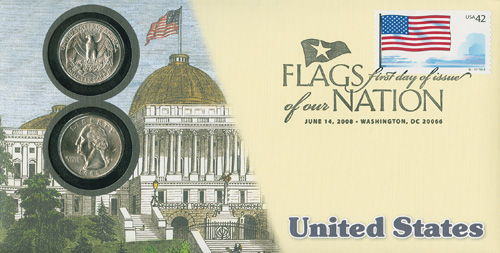
Click here for more Flags of Our Nation Coin Covers as well as single stamps and sets.
Click here to get the complete set of 60 Flags of Our Nation stamps in one convenient set.
The state and territory flags of the U.S. offer a unique glimpse into the history of each place. Every flag features important people, dates, places, or events that are significant to each state or territory. In many cases, the choice of color is a deliberate reference to something in the state's background. Many of the current U.S. state flags date back to the 1890s. At that time, states wanted to have unique symbols of representation for display at the 1893 World's Columbian Exposition.
In 1938, a design created by graphic designer Charles A.R. Dunn was officially adopted as the flag of the District of Columbia. Inspired by George Washington's family coat of arms, the flag design consisted of three red stars (known as mullets) and two red bars.
The first state flag of Florida was created in 1868. It consisted of the State Seal of Florida on a white field. In 1985, realizing the inaccuracies of the state seal, the Florida government changed its design. It now has a Seminole Indian woman, a sabal palm tree (the official Florida state tree), and a more appropriate boat than the previous seal.
In 2003, after countless flags and years of discussion, newly elected Georgia Governor Sonny Perdue resolved to put an end to this dispute. The new flag consisted of the "stars and bars" from the first flag of the Confederate States of America, with the Georgia State Seal in the blue canton.
The flag of Guam consists of a red border, representing the blood shed by the people of Guam while under Spanish rule and during World War II. Within the border is a blue field, symbolic of the Pacific Ocean which surrounds the island. The central focus of the flag is the Great Seal of Guam. The seal is designed in the shape of a sling stone, which was used by the native Chamorro people to hunt and fight, symbolizing survival. Inside the sling stone is a coconut palm, symbolizing perseverance and sustenance. There is a canoe, known as a flying proa, which represents courage and freedom. The seal also shows a river leading to the sea, showing Guam's readiness to share its resources. In the background is Two Lovers' Point, representing Guam's faithfulness and commitment to its future people.
Hawaii's state flag has remained virtually unchanged since its creation in 1816. The flag consisted of eight red, white, and blue stripes with the flag of Great Britain in the upper-left corner. The eight stripes represent the eight main islands of Hawaii, while the Union Jack (another name for the flag of Great Britain) symbolizes the friendship between Hawaii and Great Britain.
The Idaho state flag was first flown in 1898 during the Spanish-American War as the banner of the First Idaho Volunteer Infantry. At the center of a blue field is the Great Seal of the State of Idaho. Within the seal are a woman (representing liberty), a miner, and other symbols honoring the state's rich history in forestry, farming, mining, and wildlife.
Illinois' state flag was officially adopted on July 16, 1915. In 1970, the flag was redesigned to include the state name. The flag features a bald eagle, representative of the United States, carrying a shield with 13 bars and stars to symbolize the 13 original colonies.
On a blue field, the Indiana state flag pictures a flaming torch, symbolizing liberty and enlightenment, and six rays, representing the expansive nature of these ideas. A circle of 13 stars represents the 13 original colonies, while a smaller circle of five stars represents the five states admitted after the formation of the United States. Directly above the torch is a larger star, signifying Indiana as the 19th state.
Iowa's state flag features an eagle on a white stripe between a red stripe (for courage) and a blue stripe (for loyalty, justice, and truth). The state name is written below the eagle in red, to symbolize the sacrifices of the men who went to war.
At the center of the Kansas state flag is the Great Seal of the State of Kansas, which pictures a landscape before the rising sun, a river and steamboat (signifying commerce), a cabin with a man plowing a field (representing agriculture), and a wagon train heading west (depicting American expansion). Also pictured is a group of Indians hunting buffalo. The cluster of 34 stars symbolizes Kansas' role as the 34th state of the American Union.
The Flags Of Our Nation Series
The state flags had been honored on US stamps once before, in 1976 as part of the Bicentennial Series (US #1633-82). Those stamps marked an important first – they were America’s first 50-stamp se-tenant. The sheet featured all of the state flags in the order the states were admitted to the Union.

In 2008, the USPS again decided to honor the state flags but in a different format. These stamps represented a US postal first. They have the beauty and historic significance of commemorative stamps, but were issued as se-tenant (face-different attached) definitive coil stamps.

The new series was called “Flags of Our Nation” and would consist of 60 stamps total – 50 featuring state flags, five territorial flags, the District of Columbia flag, and four US flags flying over American landscapes described in “America the Beautiful.” The stamps in the new set would be issued in alphabetical order by state or territory. Each stamp would feature a flag and a “snapshot” from the state or territory. These snapshots would include scenic areas, plants, animals, and more.
The first set of stamps was issued on Flag Day, June 14, 2008 at the National Postal Museum in Washington, DC. It featured the flags of Alabama through Delaware, American Samoa, and the American flag with “spacious skies.”
In speaking about the stamps, a USPS representative said, “Flags are our nation’s greatest symbols for unity and pride and the values we hold dear. The Postal Service is proud to present this tribute as we honor our nation’s flags.” That same day, special events were held in the nine state capitals whose flags were featured in that first set of stamps.

The second set in the series was issued later in 2008, on September 2. As with the first set, there were special ceremonies in the state capitols of those states featured on this set of stamps. The stamps in this set featured the flags of Florida through Kansas, the District of Columbia and Guam.

Initially, two sets of 10 stamps were supposed to be issued each year for three years. However, in 2009 it was decided that each year would only include the issue of one set of 10 stamps. The third set was issued on August 6, 2009 at the American Philatelic Society Stamp Show in Pittsburgh, Pennsylvania. These stamps featured the flags of Kentucky through Missouri as well as the US flag with “amber waves of grain.”

The fourth issue in the series was released on April 16, 2010 at the Mega Stamp Show in New York City. These stamps featured the flags of Montana through North Dakota with the US flag above “purple mountain majesties.”

The fifth set was issued on August 11, 2011, at the American Philatelic Society Stamp Show, in Columbus Ohio. These were the first in the series to be issued as Forever stamps. Featured on these stamps were the flags of Ohio through Tennessee, Puerto Rico, and the Northern Mariana Islands.

The series came to a close on August 16, 2012, with the sixth and final set. These stamps were issued at the American Philatelic Society Stamp Show in Sacramento, California. Featured on these stamps were the flags of Texas through Wyoming, the Virgin Islands, and the US flag with “the fruited plain.”

Click here for more Flags of Our Nation Coin Covers as well as single stamps and sets.
Click here to get the complete set of 60 Flags of Our Nation stamps in one convenient set.







